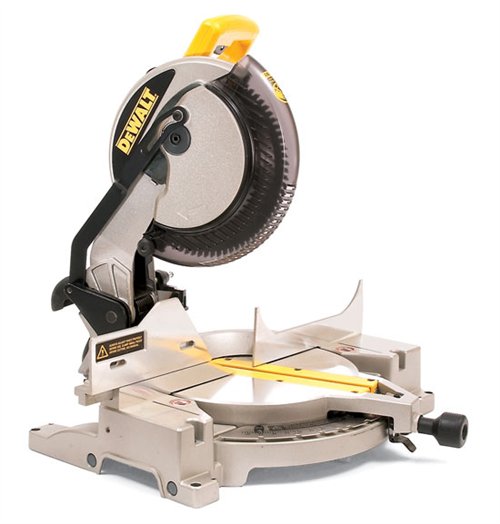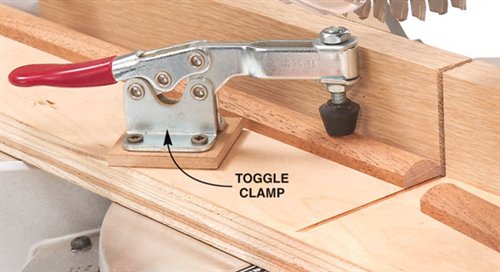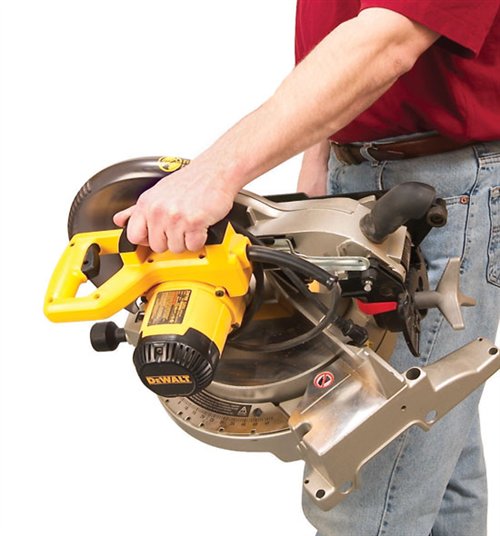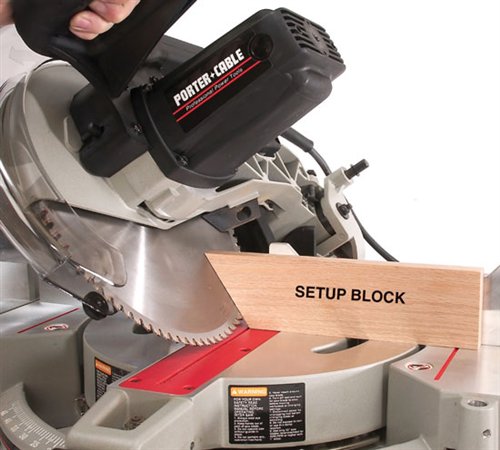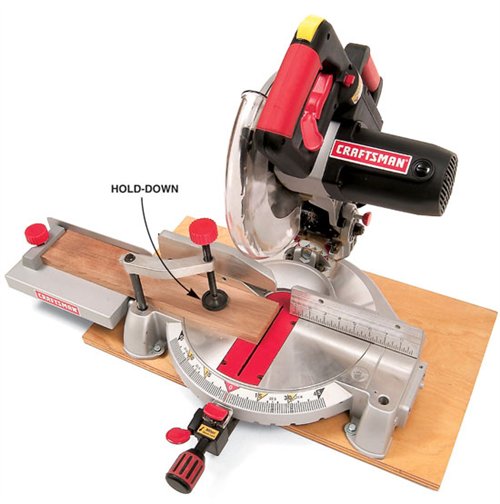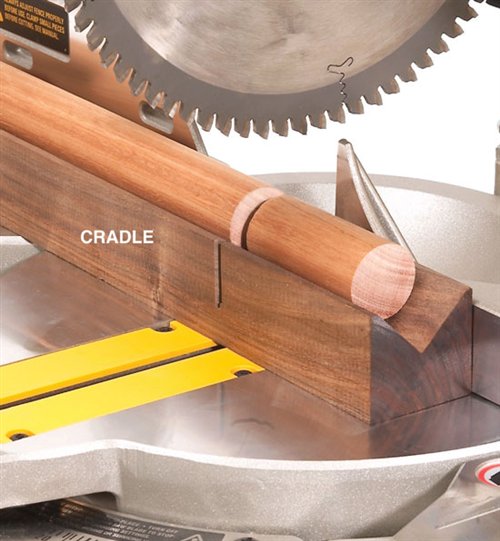We may receive a commission when you use our affiliate links. However, this does not impact our recommendations.
Tips for Mastering the Miter Saw
14 Ways to Make Safe, Accurate Cuts with No Tear-Out
by Tom Caspar
At first glance, using a miter saw appears quite simple. But to get good results—that’s another story! Here are a handful of techniques and jigs, for pieces large and small, to help you make absolutely straight, splinter-free cuts right on your layout lines.
Push Your Fence Back
Straight pieces of molding are easy to cut on the miter saw, but how about those snarly bent ones? If you have an extended fence, accurately cutting their ends requires one simple adjustment. Push the fence extension back and out of the way, so a bend won’t prevent you from holding the molding tightly against the saw’s own fence. Use this technique for flat boards that are bent, too.
One Blade Can Do It All
Most miter saws come with a blade that’s fine for cutting 2x4s, when a bit of tear-out or a slightly rough surface really doesn’t matter. For better performance when cutting hardwood and plywood, replace the original blade with a blade that has a high tooth count and a negative rake. Leave this replacement blade in your saw for cutting all types of wood.
A negative rake means the teeth lean slightly backward and cut less aggressively. A 10-in. high-tooth-count blade has 60 to 80 teeth; a similar 12-in. blade has 70 to 100 teeth. Plan to spend at least $70 for one; the price increases with the number of teeth.
Back Up Thin Stock
Make a sacrificial two-sided miter box when you’re slicing thin stock into short pieces. Mount a toggle clamp on the box to safely hold your work (see Source, below). Fasten the box to your saw’s fence so it won’t move. Then cut a slot partway through. Use the slot to align the layout mark on your workpiece. This box also acts as a back stop so the cutoff won’t fly away. It also prevents tear-out below and behind the cut.
Carry It Compactly
Rotate your saw’s turntable all the way, left or right, to make the saw more compact and easier to carry. This puts the handle closer to the saw’s center of gravity, so it’s easier to balance.
Set Bevel Angles with a Block
When’s the last time you tried to read your saw’s bevel scale, the one that tells you how far the blade is tilted? Those scales are often divided by illegible lines and have crude cursors caked with dust. It’s much easier to make a setup block than to read the scale.
To make the block, leave the blade at 90 degrees with no tilt. Rotate the saw table to the angle you want. Place the block flat on the table and cut it. Rotate the table back so it’s square to the fence. Stand the block on edge to adjust the blade’s tilt.
Check Your Throat Plate
Most throat plates are set slightly below the saw’s table, as indicated by this piece of paper. The throat plate should be level with the table to reduce tear-out and prevent a thin piece from bending as it’s cut. If your throat plate sits too low, remove it from the saw and shim it by putting tape on the ledge underneath the plate.
Use the Hold-Down
A little creep can ruin a good cut. The best way to prevent a board from wiggling is to use your saw’s hold-down clamp. I’m sure you’ve already figured out that regular clamps don’t work well for this job. Unfortunately, most miter saws don’t have flat surfaces underneath the table to receive a clamp. The backs of many fences don’t have flat spots either.
Miter saws’ hold-downs are a mixed bag. Some work well; others are difficult to adjust or don’t hold the work steady enough. Inconvenient or not, most hold-downs do increase the accuracy of any cut.
Cut Dowels with a V-Block
Make a V-shaped cradle to prevent dowel stock from rotating when the blade hits it. If your saw has a depth stop—a very handy feature—set the stop so the blade won’t cut all the way through the cradle.
To make the cradle, tilt your tablesaw blade to 45 degrees. Raise the blade until it cuts about 3/16 in. below the top of the V (see inset photo). Turn the board end for end and cut the opposite side. This partial-cutting method prevents the waste from shooting back at you at the end of the second cut. Snap off the waste piece by hand. Raise the blade and finish the V shape.
Wait Until the Blade Stops
Be honest: How many dangerous missiles have you launched from your miter saw? We’ve all done it. Small cutoffs are the worst, of course. But it’s not rocket science to figure out how to ground them: Don’t lift the blade until it stops. Make the cut, let go of the trigger and count to five. That’s not so hard, is it?
Raise Your Work for More Capacity
When your blade won’t cut all the way across a wide board, try raising the board on a platform. It may seem weird, but this effectively increases your saw’s crosscut capacity. The amount varies from saw to saw. Here, on this 10-in. saw, each piece of 3/4-in. plywood placed under the workpiece widens the cut by 1/2 in. Adding two pieces gains 1 in., just enough to make a full-width cut. Be sure to use a hold-down, so the blade’s steeper cutting angle at the cut’s far side doesn’t lift the workpiece.
A Subfence Increases Precision
Screw a subfence to your saw when you must make precise right-angle cuts. Line up your pencil mark with the fence’s slot and voil`a! the blade cuts exactly on the mark. The cut’s back side will be as clean as a whistle with no tear-out.
To make a subfence, start with a board that’s the full length of the saw’s fence. Use a dense hardwood, such as maple. Using your tablesaw, cut a 1/8-in.-wide rabbet along one edge of the board. This creates a small gap for sawdust, so you can hold your workpiece tightly against the subfence. Screw the board to your saw’s fence and cut a slot all the way through it.
Economical Stop
Use a stop block to ensure each piece you cut is exactly the same length. This stop is easy to make and adjust. It’s just a piece of plywood or solid wood with a carefully cut slot (see inset photo). The slot fits tightly around the bar of an F-style clamp. When you move the clamp, the block goes, too. Use your miter saw to cut off one of the block’s corners so sawdust won’t be trapped between the block and your workpiece.
Mark the Middle
Where does the blade cut first? It starts at the board’s middle, of course. That’s where your layout mark should be, rather than at the board’s edge.
When you mark a board for length, indicate the waste side with a big X. To align the blade with the pencil mark, keep your finger off the trigger and lower the blade until one tooth is a hair above the board. Shift the board until the mark lines up with blade. Raise the blade and then make the cut.
Is Your Saw Still Square?
Most saws cut reasonably square out of the box, but they may not stay that way. It’s good practice to check yours now and then and readjust as needed.
My favorite precision tool for this job is a plastic drafting square. It only costs a few bucks at any office supply store and doesn’t mind getting dropped. Using my miter saw, I cut off a corner to shorten one of the square’s sides. This way, the blades’ teeth don’t interfere with the alignment check.
Source

This story originally appeared in American Woodworker July 2006, issue #122.
Here are some supplies and tools we find essential in our everyday work around the shop. We may receive a commission from sales referred by our links; however, we have carefully selected these products for their usefulness and quality.



